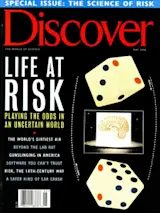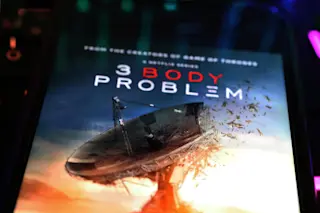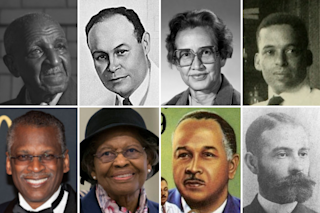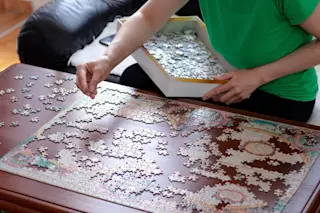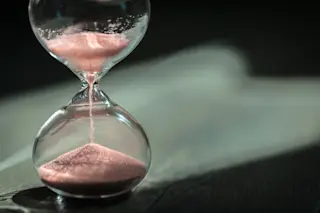Imagine my relief when I made it out of bed alive last Monday morning. It was touch and go there for a while, but I managed to scrape through.
Getting up was not the only death-defying act I performed that day. There was shaving, for example; that was no walk in the park. Then there was showering, followed by leaving the house and walking to work and spending eight hours at the office. By the time I finished my day--a day that also included eating lunch, exercising, going out to dinner, and going home--I counted myself lucky to have survived in one piece.
Until recently I’d had no idea that an ordinary Monday could be such an extraordinary minefield--but a minefield it is. According to mortality studies conducted by dozens of organizations, from the National Safety Council to the American Medical Association, the Department of Health and Human Services, and the Departments of Transportation and Commerce, there is not a single thing you can do in an ordinary day-- sleeping included--that isn’t risky enough to be the last thing you ever do. In 1994 professor of philosophy Larry Laudan of the University of Hawaii collected all these dire findings and published them in a sort of handbook of everyday hazards that he dubbed, appropriately enough, The Book of Risks. Against my better judgment, I recently decided to consult Laudan’s collection to determine just how serious the dangers are that everyman faces every day. The everyman I picked was me, the day I picked was a Monday, and the news, I learned, was grim indeed.
My 24-hour gantlet began shortly after midnight when I turned off the light and got into bed. Bad move. For most people, few places seem like more of a refuge from risk than bed, and with good reason. Even the most sensational tabloid rarely finds itself reporting on a rash of contour- sheet-related deaths; even the most tawdry talk show rarely devotes a full hour to the Dust Ruffle Killer. But perils exist under the covers nonetheless. In an ordinary year, about 130 Americans--or 1 out of every 2 million--will die from falling out of bed. Over the same period, 1 out of 400 will be injured just lying in bed, generally because of the headboard collapsing, the frame giving way, or some other mechanical failure. More dramatic than these dangers is the risk you take when what you’re doing in bed is a good deal more passionate than just lying there.
It was former vice president Nelson Rockefeller who perhaps best described the danger of a brief amour leading to a permanent au revoir when he said--and this, of course, is a thirdhand quote--Aargh. If you’re an adult over 35, you run a considerable risk of heart attack no matter how you spend your time--about 1 in 77 in the course of a year. Over the span of your entire life, that risk climbs to a sobering 1 in 3. Just when a coronary will hit is impossible to predict, but it’s a safe bet that the risk climbs measurably when a person suddenly segues from a resting state to a state of high exertion--and there is often no higher exertion than passion. Curiously, there are no firm numbers on just what percentage of the nation’s 500,000 annual heart attack deaths take place flagrante delicto, though when the problem does occur, studies suggest that the victim is most likely to be a middle-aged man--usually one who’s spending quality time with someone other than his middle-aged wife.
Given that I did not, uh, put myself in a position to suffer a heart attack in the wee hours of this particular Monday, the night passed uneventfully. But as soon as my alarm clock went off at 6:30 the next morning, I had other things to fear. During the course of the year, the average American faces a 1 in 13 risk of suffering some kind of injury in the home that will necessitate medical attention, and I realized that just by getting up I was starting to play those odds. Would I be electrocuted when I reached to turn my alarm clock off or my night-table lamp on? The numbers said there was a 1 in 350,000 chance that I would. Would I trip as I put my feet on the floor, falling and suffering a fatal skull fracture? There was a 1 in 20,000 likelihood that that would happen. Happily, I negotiated these hazards successfully and made my way to the bathroom to brush my teeth. Here, I well knew, more danger lay in wait.
Like most New Yorkers, I’ve long heard the local boast that the city’s reservoirs brim with some of the purest water in the country--and like many New Yorkers, I’ve long questioned it. Experience has taught me that from any given faucet in any given borough, the local water may emerge in one of any given colors--usually within a range of handsome earth tones. Maybe it brands me finicky, but when the best thing you can say about a fresh glass of tap water is that it doesn’t clash with a pair of olive green dress slacks, I would just as soon reach for a Sprite. According to The Book of Risks, however, the dangers associated with tap water go far beyond the aesthetic. In most communities there is at least a 20 percent chance that the local water supply is not sufficiently chlorinated to kill infectious bacteria. Worse, in most private homes and apartment buildings there is a similar 20 percent risk that outmoded pipes and soldered joints have introduced what the government considers a dangerous level of lead into the water stream.
Only a little less troubling than my sink was my shower. During the course of a lifetime, there is perhaps no more ignominious accident than falling while showering. Each time it starts to happen, I’m convinced I’m going to be able to regain my balance with the surefootedness of Peggy Fleming, and each time I wind up closer to Peggy Cass. Despite the seeming commonness of shower falls, however, the average person faces barely a 1 in a million chance annually of being seriously injured in such a spill. Far more common in the bathroom mishap category is the shaving injury, which 1 in 7,000 people annually will experience seriously enough to require medical attention. To be sure, both of these risks seem manageable enough, but since I generally shave in the shower--usually with a disposable razor I last replaced during the final year of the Carter administration--I figured my risk was compounded.
More disturbing--and, I’d like to think, more remote--than the risk I faced from all of these things was the risk I faced from, well, my toilet. According to The Book of Risks, this year and every year 1 in 6,500 Americans will somehow be injured by his or her toilet. The book is coy about elaborating on the nature of the accidents, and that’s probably just as well, though Laudan does reveal that in almost all cases the luckless victims are men. I suppose if I took a moment to contemplate the anatomy of both toilet and male, I could come up with a couple of plausible injury scenarios, but I won’t be taking that moment.
When I finally finished getting dressed (fully cognizant of the fact that I run a 1 in 2,600 annual risk of being injured on a snap, zipper, or some other part of my clothing) and gathered up my belongings (equally aware that I run a 1 in 9,000 risk of cutting myself on paper money or coins), I was at last ready to leave the house and brave the streets. Once I did, I knew I would encounter one of the most formidable sources of risk I was likely to face all day: crime. Of all the cities in the world, none seems quite as hospitable to lawbreakers and mayhem makers as New York. To people who live outside the five boroughs, crime is now thought of as such an unavoidable part of Gotham life that the criminals themselves are seen less as out-of-control outlaws than as permanent parts of the local service economy (Hi, my name is Brett; I’ll be your assailant this evening). But New York is hardly America’s only nasty burg, as Laudan’s nationwide crime numbers vividly reveal.
In any given year, the average American faces a 1 out of approximately 14 risk of having property stolen, a 1 out of 32 risk of being the victim of some type of violent crime, and a 1 out of 11,000 probability of that crime being a homicide. The likeliest month for violent crimes is August, with its wilting humidity and heat-frayed tempers; the least likely is the less oppressive February. The likeliest single day of the year for a murder to take place, however, is January 1, with its evident connection to New Year’s Eve celebrations and increased alcohol intake. If you are murdered--something The Book of Risks by no means recommends--there is a 66 percent likelihood that the weapon used to do the job will be a gun. This, of course, is bad news for the National Rifle Association, which continues to stand by its oft-repeated claim that guns don’t kill people, crazed hit men wielding cheese croissants kill people.
On this particular morning, things seemed criminally quiet on my block, but just because the hoods appeared to be staying home did not mean the ’hood itself was safe. Ahead of me, I still had a long--and, I newly realized, hair-raising--walk to work. Negotiating New York sidewalks and crossing New York streets means encountering New York taxis, and encountering New York taxis means trouble. In the 17 years I’ve lived in Manhattan, I’ve never quite understood the appeal of the local cab. Maybe I’m just skittish, but any time you enter a vehicle driven by a man who makes change in Uzbeki currency, thinks the shortest route to LaGuardia Airport runs through Vermont, and appears to believe, despite all evidence, that it’s indeed possible to pop a wheelie in a ’91 Chevy Caprice, you may want to give some thought to the bus. As it turns out, however, the people imperiled by New York City taxis are not only passengers but pedestrians.
According to The Book of Risks, nearly 33 percent of all people killed in urban traffic accidents are passersby, with the average pedestrian having about a 1 in 40,000 annual risk of joining their ranks. While 1 in 40,000 seems pretty tolerable, in a city like New York, with 7.5 million people, that means 187 pedestrians cashing in their chips, tokens, and bus transfers every year. If it’s any consolation to people who still insist on walking to work, the annual nationwide risk of being killed in an accident if you’re inside a car is much higher--about 1 in 11,000; and the annual odds of dying in any kind of motor vehicle accident--whether you’re a driver, passenger, or pedestrian and whether the vehicle involved is a motorcycle, car, or truck--is 1 in 5,800.
Once again, luck appeared to be on my side, and I arrived at my office without incident. But surviving the perils of my walk meant facing the perils of my breakfast, and the risk, I knew, was considerable. Ordinarily, my breakfast of choice is a bran muffin, a food that not too long ago was considered the healthiest of health fare. In recent years, however, bran muffins have grown in both size and variety, so that the commercial muffins found in most stores now measure only slightly smaller than a single-family dwelling and feature all manner of unlikely ingredients, including raisins, currants, walnuts, pecans, lost car keys, overdue library books, and whole sets of missing luggage. Is it possible, I began to wonder this morning, that a bakery product that requires a zoning easement and a building inspector before it can be sold is not the best way to start my day? As it turns out, it’s not only possible but probable.
The average American, according to The Book of Risks, consumes roughly 64 pounds of fats and oils every year and another 65 pounds of sugar. This, not surprisingly, leads to average Americans becoming larger than average Americans, and this leads to problems. A body weight just 7 percent above the ideal can shave one year off the typical life span. A 14 percent weight boost can cost two years, and so on until individuals more than 100 pounds above the ideal body weight find themselves fully 50 percent more likely to die in any given year than their more svelte peers. Taking all Americans of all weights into consideration, the odds of any one person’s dying from obesity in any one 12-month period are about 1 in 200,000.
Trusting that at least for now I wouldn’t be that one, I threw culinary caution to the wind and went ahead with my scheduled muffin--as near as I could tell without any ill effects. Having made it past that particular hurdle, I suspected that the rest of my workday would be relatively risk free, and for once it appeared I was right. It is something of an accepted workplace truth that the less physical your job is, the less likely you are to sustain any serious employment-related injury. For editors and writers like me, that’s cause for cheer, because while it’s possible to imagine a life-form more sedentary than a journalist--coral, for instance--not many come immediately to mind. According to The Book of Risks, this indeed pays dividends.
If you, like me, are an office worker, your annual likelihood of dying in a job-related accident is 1 in 37,000. If you’re a slightly more mobile salesperson, the risk rises to 1 in 24,000; in manufacturing, it’s 1 in 23,000, and in civil service and government, 1 in 11,000. After this, the numbers start to get truly dicey, with transportation workers like train engineers and bus drivers generally running a 1 in 4,500 risk, and airline pilots in particular confronting a knuckle-whitening 1 in 1,100. (Airline passengers face a far lower annual risk of flight-related death than pilots--barely 1 in 250,000. Pilots face the increased risk because of the greater number of hours they spend aloft.) And what business carries the greatest likelihood of workplace calamity? The poultry-slaughtering industry, whose employees face a 43 percent annual risk of serious injury (a figure that presumably doesn’t include the death rate of the poultry themselves, which clock in at a cool 100).
As the numbers promised, my eight hours on the job passed uneventfully, but as soon as I left the office at the end of the day, I had to steel myself for what I knew would be the day’s most dangerous liaison: dinner and drinks with friends. Ordinarily, I would look forward to an evening out as the highlight of any working day, but The Book of Risks made it clear to me how wrong I’ve been. According to Laudan, there was almost no item I could order from the menu in almost any restaurant that wouldn’t threaten to polish me off long before I could begin to polish it. Seafood? Fine, as long as I was willing to accept that two out of every three servings of fish sold in the United States have gone straight from the net to the plate without any government inspection of any kind. Pork? Sure, as long as I understood that while this particular entrée might be more than 12 times less likely to cause food poisoning than fish, it’s more than twice as likely as beef. How about a steak, then? No problem, as long as I appreciated the fact that if I made charbroiled beef even a weekly part of my diet, it would raise my lifetime cancer risk by an additional 1 in 50,000--five times my annual risk of dying in a plane crash. Suppose I eschewed virtually everything on the menu and ordered nothing more than a pure and pristine bottle of designer water? Excellent choice--as long as the bottle of water I got was not among the 30 percent that are contaminated with bacteria beyond the permitted threshold.
Playing it relatively safe, I ordered a pasta and salad, picked at them warily and, hoping I could beat the 1 in 150 odds that I would develop heartburn that day, headed for home. With only a couple more hours left until midnight, I could at last see the light at the end of the risk tunnel. Even so, it was hard to relax completely. How did I know this wouldn’t be the evening that the odds would catch up with my 1 in 21 million annual risk of dying from a snakebite or a black widow spider attack, or my 1 in 2 million annual risk of being done in by a tornado? And what about my 1 in 700 lifetime risk of suffering an acute appendicitis attack?
That night at least, my appendix appeared willing to keep its hands to itself, and making it safely home, I eventually--and gratefully-- slipped into bed. Before I drifted off, however, a thought occurred to me and I got back up and opened the blinds. I know that all of us face only a 1 in 25 million annual risk of being hit by a falling airplane, but with not many more than 5 billion people on the planet, at least a few of us have to have a plane with our name on it. I can’t speak for you, but I’m not about to be taken by surprise.


